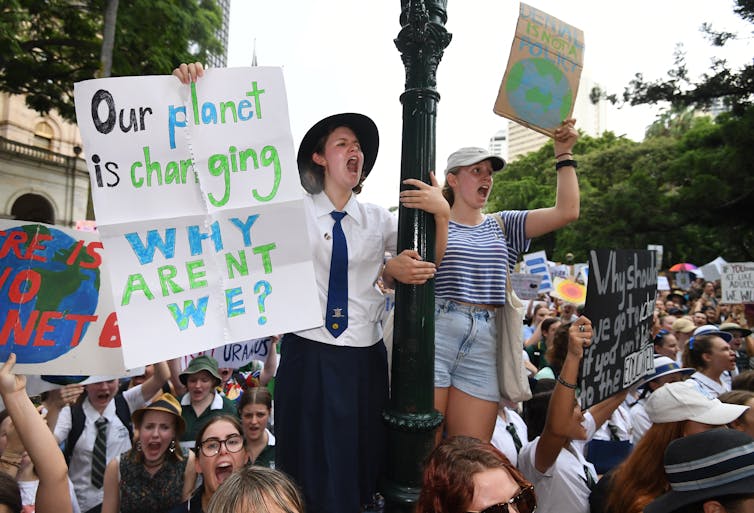Young people won't accept inaction on climate change, and they'll be voting in droves
- Written by Hannah Feldman, PhD Researcher in Science Communication, Australian National University
Today young Australians will hit the streets for the second Climate Strike of 2019.
Youths are often brushed off as being politically disengaged, but the Australian Electoral Commission has reported record high numbers of youth enrolment, and climate change will be at the forefront of their minds when many take to the polls for the first time.
But unlike older generations, who develop and stick to lifelong party allegiances, we’re seeing dramatic shifts in the way young people vote, choosing sides based on issues and specific policies instead.
Slowly, we’re beginning see governments respond to climate change protests. Yesterday the UK Parliament declared a climate emergency, one of the demands from the Extinction Rebellion group who marched for ten days across London.
But there’s still much more to do. And the youth Climate Strike movement shows us loud and clear that young people not only care about climate change, but that it needs to be brought to the table to cement their vote.
Changing of the guard on party politics
The classification of “political engagement” around the world has traditionally had a strong citizenry focus: campaigning for a political party, joining unions, writing letters to MPs, and many other activities that would seem positively archaic to youth today.
 Students at Brisbane’s Climate Strike in March, 2019.
AAP Image/Dan Peled
Students at Brisbane’s Climate Strike in March, 2019.
AAP Image/Dan Peled
Generation Z doesn’t need a town hall meeting or front bar at the Union Pub to get up to date information on their communities. Online communities mean they can find their tribe and pinpoint the political issues they care about, like climate change.
Read more: Students striking for climate action are showing the exact skills employers look for
As a result, they’re more likely to focus their political attention on specific causes. For those voting for the first time on May 18, being politically active can mean product boycotts or endorsements, signing petitions and, as with Climate Strike, protest movements.
While protests are an ancient tradition, Climate Strike is being led entirely by school students. Greta Thunberg, now aged 16, began the School Strike for Climate movement after attracting press to a then solitary protest at Swedish parliament in 2018.
By March 15, 2019, the movement had grown to over 1.4 million students in more than 300 cities worldwide.
This movement forces adults to acknowledge climate change is not only impacting the futures of an unknown, unborn generation, but also of those protesting here and now.
Climate change, then, is not only an important issue for under 24-year-olds, but also a deeply personal one. Discussion of climate change often elicits intense emotions like fear and anxiety for their futures.
In a speech earlier this year in Davos, Switzerland, Thunberg said:
adults keep saying: ‘We owe it to the young people to give them hope.’ But I don’t want your hope. I don’t want you to be hopeful. I want you to panic. I want you to feel the fear I feel every day. And then I want you to act.
Read more: Greta Thunberg at Davos: why Gen Z has real power to influence business on climate change
But despite their concern and focus on climate change as a political issue, very few young people have felt they could influence anything on a large scale. With Climate Strike, this may be changing.
Today’s issues, tomorrow’s voters
Young Australians have felt helpless and frustrated when it comes to curtailing climate change for several decades. This has flow-on effects that see youth hesitant to take action, especially considering no one likes to get involved in political issues they don’t feel like they can affect.
 Climate change is the future for young Australians, and they won’t wait until they’re older to take action.
Dean Lewins/AAP
Climate change is the future for young Australians, and they won’t wait until they’re older to take action.
Dean Lewins/AAP
What’s more, Millennials and Generation Z are often labelled “lazy” or “entitled” free loaders in public discourse. This leads to a further retreat from political issues, and young people living up to the low expectation already set for them. It’s a cruel cycle.
But in 2017, young people were presented with a perfect opportunity to effect change in on a single issue: the same-sex marriage postal survey.
During this time, 100,000 Australians registered to vote for the first time, with 65% under the age of 24. These newly enrolled voters will also be stepping up to their first federal election in 2019, and they’re now feeling empowered to bring climate change to the table.
Read more: Marriage survey: two-thirds of new voters are aged 18-24
High profile protest movements such as Climate Strike don’t just help to make changes in the political arena. Participants are left feeling confident about the change they can make to a cause.
The result: we have a young generation more engaged with climate change policy than ever before.
After 150,000 young Australians attended Climate Strike in March 2019, one can’t help but to sit up and take notice of this vocal group of people.
As with any demographic, there will be those who continue to vote impulsively, without much consideration for their choice. But there will also be a considerable portion that vote on the issues that matter to them.
All told, climate change needs to be addressed in a real and meaningful way to win over these new voters. Those who can’t vote this election will soon be charging at the next.
Authors: Hannah Feldman, PhD Researcher in Science Communication, Australian National University



















